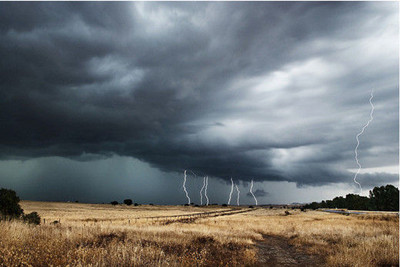(单词翻译:单击)
听力文本
There's nothing like that fresh, rain-washed air after a storm, right?
The idea has always been the rain is cleaning.
Mary Gilles, a chemist at Lawrence Berkeley Lab.
She and her colleagues study microscopic airborne particles, so normally we don't collect during rain.
Because our intuition is, the air's clean, why would we be collecting right now?"
Two years ago, they went against that intuition and collected after a rainstorm, at a field in northern Oklahoma.
And what they found was actually a wealth of particles—about half a micron in diameter, nearly spherical, and glassy-looking under the microscope.
Lab analysis revealed the miniscule bits to be carbon-based blobs of soil material—like decayed bits of plants and soil-dwellers.
But how they got airborne was a mystery.
The researchers think that what’s happening, based on a follow-up experiment, goes something like this.
The rain leads to puddles.
Organic matter leaches into those puddles, forming a film on top of the water.
Then, as raindrops strike, they form tiny air bubbles.
These bubbles rise to the surface and burst through that layer of organic material, catapulting the soil particles into the air.
The study is in the journal Nature Geoscience.
Tiny as they may be, the particles may actually affect the climate.
We think that they have the potential to actually be absorbing incoming solar radiation, and then that feeds back into global climate change.
Meaning we might want to factor them into climate models.
Cause they appear to be more than just dust in the wind.
参考译文
“没有什么比的上暴风雨过后清新,被雨冲刷过后的空气了,对吧?
人们一直认为降雨具有净化的作用。”
劳伦斯伯克利实验室的化学家玛丽·吉尔斯说道。
她和同事们研究只有 显微镜下才可见的的大气微粒,因此通常,我们不会在下雨时收集。
因为我们的观点是,空气这样洁净,为什么还要收集呢?”

但2年前研究人员将这样的想法彻底推翻,在暴风雨过后的俄克拉何马州北部田地里他们进行了大气微粒的收集。
结果他们发现空气中实际上包含大量直径约半微米,近乎球形,在显微镜下呈现光亮透明的微粒。
而实验分析表明这些微粒原本是以碳为基础的土壤物质,比如在腐烂的植物和其他土壤寄居物中就能发现。
但它们如何升空成为大气中的微粒仍是一个未解之谜。
研究人员认为情况是基于以下他们进行的实验。
下雨会导致地面形成水坑。
有机物质渗入水坑后就会在水面上形成一层薄膜。
随着持续降雨,它们就会形成极其微小的气泡。
这些气泡浮到水面冲破最上面的一层有机材料后将土壤颗粒携带到大气中。
这项研究已在《自然地球科学》杂志上发表。
尽管这些土壤的微粒极其细微,但也会对气候造成影响。
“我们认为这些物质会吸收太阳辐射,而后影响全球气候变化。”
这意味着我们也要把这些微粒纳入进气候模型的考量当中。
“因为这些微粒看起来不仅是风中之尘。”
译文为可可英语翻译,未经授权请勿转载!
重点讲解
1.go against 违背
例句:Changes are being made here which go against my principles and I cannot agreewith them.
这里作的改动违背了我的原则,我不能同意。
2.base on 基于
例句:There was no strong organizational base on which to build.
缺乏一个坚实的组织基础。
3.lead to 导致
例句:A lack of prudence may lead to financial problems.
不够谨慎可能会导致财政上出现问题。
4.want to 想要
例句:I don't want to leave, but I can't go on.
我不想离开,但我继续不下去了。


